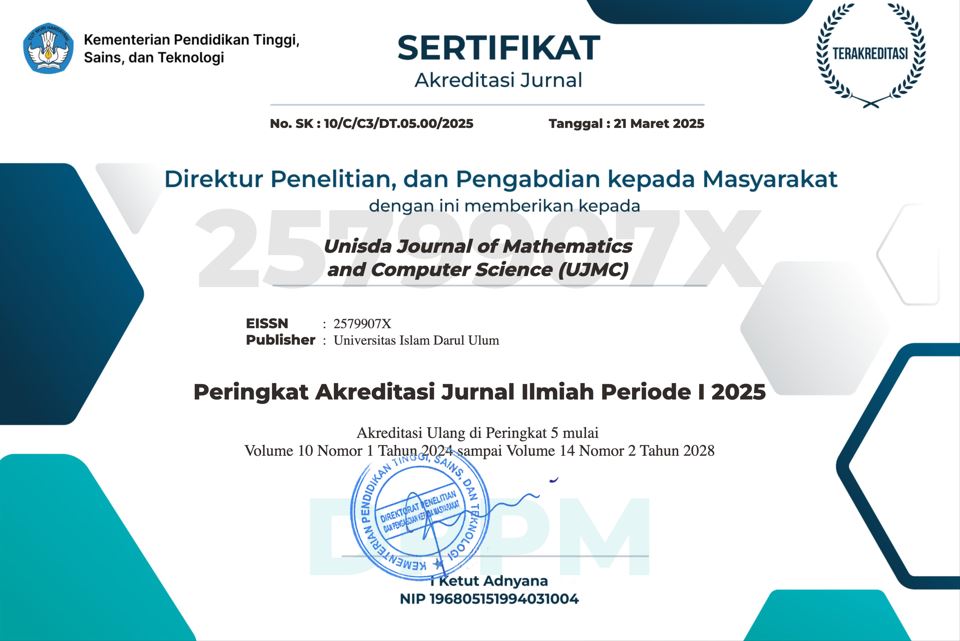Dekomposisi dari Modul Yang Dibangun Secara Hingga Atas Beberapa Ring Khusus
Abstract
This study wants to provide a decomposition of the module that was built into a number of special rings, such as the principal ideal domain or the Dedekind domain. The main result of this study is that the decomposition of the finitely generated module is the direct sum of the torsion module and the independent module when the ring is the principal ideal domain. When the ring is the Dedekind domain, the decomposition is the direct sum of the projective module and the torsion module.
Abstrak
Penelitian ini ingin memberikan dekomposisi dari modul yang dibangun Secara hingga atas beberapa ring khusus, seperti daerah ideal utama atau daerah Dedekind. Hasil utama dari penelitian ini mendapatkan dekomposisi modul yang dibangun secara hingga adalah jumlah langsung dari modul torsi dan modul bebas saat ring adalah daerah ideal utama. Saat ring adalah daerah Dedekind, didapatkan dekomposisi merupakan tambah langsung dari modul projektif dan modul torsi.
References
[2] M. Fahmi and N. Rosli, “Comparative study of Stochastic Taylor Methods and Derivative-Free Methods for Stochastic Differential Equations,” in Journal of Physics: Conference Series, Aug. 2021, vol. 1988, no. 1. doi: 10.1088/1742-6596/1988/1/012005.
[3] R. Utami, M. Hadijati, and I. G. A. W. Wardhana, “Intervention Model of IDX Finance Stock for the Period May 2010 - May 2020 Due to the Effects of the Corona Virus,” IOP Conference Series: Materials Science and Engineering, vol. 1115, no. 1, p. 012057, 2021, doi: 10.1088/1757-899x/1115/1/012057.
[4] I. G. A. W. Wardhana, P. Astuti, and I. Muchtadi-Alamsyah, “On almost prime submodules of a module over a principal ideal domain,” JP Journal of Algebra, Number Theory and Applications, vol. 38, no. 2, pp. 121–128, Apr. 2016, doi: 10.17654/NT038020121.
[5] I. G. A. W. Wardhana and P. Astuti, “Karakteristik Submodul Prima Lemah dan Submodul Hampir Prima pada Z-Modul Zn,” Jurnal Matematika & Sains, vol. 19, no. 1, pp. 16–20, 2014.
[6] I. G. A. W. Wardhana, N. W. Switrayni, and Q. Aini, “Eigen Mathematics Journal Submodul Prima Lemah dan Submodul Hampir Prima Pada Z-modul M2(Zn),” Eigen Mathematics Journal, vol. 1, no. 1, pp. 28–30, 2018, Accessed: Dec. 20, 2021. [Online]. Available: https://doi.org/10.29303/emj.v1i1.6
[7] R. Juliana, I. G. W. W. Wardhana, and I. Irwansyah, “Some Characteristics of Prime Submodules of Gaussian Integer Modulo over Integer”.
[8] M. A. Misri, H. Garminia, P. Astuti, and Irawati, “A note on bézout modules,” Far East Journal of Mathematical Sciences, vol. 99, no. 11, pp. 1723–1732, 2016, Accessed: Dec. 20, 2021. [Online]. Available: http://dx.doi.org/10.17654/MS099111723
[9] M. Ali Misri, H. Y. Garminia, and J. By Pass Perjuangan Kesambi, “GENERALIZATION OF BÉZOUT MODULES,” 2013. [Online]. Available: http://pphmj.com/journals/fjms.htm
[10] G. Elfiyanti, I. Muchtadi-Alamsyah, F. Yuliawan, and D. Nasution, “On the category of weakly U-complexes,” European Journal of Pure and Applied Mathematics, vol. 13, no. 2, pp. 323–345, 2020, doi: 10.29020/nybg.ejpam.v13i2.3673.
[11] N. Hijriati, S. Wahyuni, and I. E. Wijayanti, “Injectivity and Projectivity Properties of the Category of Representation Modules of Rings,” in Journal of Physics: Conference Series, Oct. 2018, vol. 1097, no. 1. doi: 10.1088/1742-6596/1097/1/012078.
[12] Fitriani, I. E. Wijayanti, B. Surodjo, S. Wahyuni, and A. Faisol, “Category of submodules of a uniserial module,” Mathematics and Statistics, vol. 9, no. 5, pp. 744–748, Sep. 2021, doi: 10.13189/ms.2021.090514.
[13] Irwansyah and D. Suprijanto, “Structure of linear codes over the ring Bk,” Journal of Applied Mathematics and Computing, vol. 58, no. 1–2, pp. 755–775, Oct. 2018, doi: 10.1007/s12190-018-1165-0.
[14] J. Kaewwangsakoon and S. Pianskool, “F-CS-RICKART MODULES,” JP Journal of Algebra, Number Theory and Applications, vol. 45, no. 1, pp. 29–54, Jan. 2020, doi: 10.17654/nt045010029.
[15] S. Sangwirotjanapat and S. Pianskool, “T-SMALL SUBMODULES WITH RESPECT TO AN ARBITRARY SUBMODULE,” JP Journal of Algebra, Number Theory and Applications, vol. 40, no. 1, pp. 91–112, Mar. 2018, doi: 10.17654/nt040010091.
[16] Steven and Irawati, “ON CHARACTERIZATIONS OF PRIME AND ALMOST PRIME SUBMODULES,” JP Journal of Algebra, Number Theory and Applications, vol. 40, no. 3, pp. 341–350, Jun. 2018, doi: 10.17654/nt040030341.
[17] I. G. A. W. Wardhana, N. D. H. Nghiem, N. W. Switrayni, and Q. Aini, “A note on almost prime submodule of CSM module over principal ideal domain,” Journal of Physics: Conference Series, vol. 2106, no. 1, p. 012011, Nov. 2021, doi: 10.1088/1742-6596/2106/1/012011.
[18] F. Maulana, I. G. A. W. Wardhana, and N. W. Switrayni, “Ekivalensi Ideal Hampir Prima dan Ideal Prima pada Bilangan Bulat Gauss,” EIGEN MATHEMATICS JOURNAL, vol. 1, no. 1, p. 1, Jun. 2019, doi: 10.29303/emj.v1i1.29.
[19] W. U. Misuki, G. A. W. Wardhana, and N. W. Switrayni, “Some Characteristics of Prime Cyclic Ideal On Gaussian Integer Ring Modulo,” 2021, doi: 10.1088/1757-899X/1115/1/012084.
[20] E. Kusniyanti, H. Garminia, and P. Astuti, “Dedekind domains and dedekind modules,” JP Journal of Algebra, Number Theory and Applications, vol. 38, no. 3, pp. 249–260, Jun. 2016, doi: 10.17654/NT038030249.

This work is licensed under a Creative Commons Attribution-ShareAlike 4.0 International License.
Authors who publish in UJMC (Unisda Journal of Mathematics and Computer Science) agree to the following terms:
1.Authors retain copyright and grant the journal right of first publication with the work simultaneously licensed under a Creative Commons Attribution License (CC BY-SA 4.0) that allows others to share the work with an acknowledgment of the work's authorship and initial publication in this journal.
2.Authors are able to enter into separate, additional contractual arrangements for the non-exclusive distribution of the journal's published version of the work (e.g., post it to an institutional repository or publish it in a book), with an acknowledgment of its initial publication in this journal.
3.Authors are permitted and encouraged to post their work online (e.g., in institutional repositories or on their website) prior to and during the submission process, as it can lead to productive exchanges, as well as earlier and greater citation of published work.









